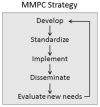NIH Mouse Metabolic Phenotyping Centers: the power of centralized phenotyping
- PMID: 22940748
- PMCID: PMC3738176
- DOI: 10.1007/s00335-012-9425-z
NIH Mouse Metabolic Phenotyping Centers: the power of centralized phenotyping
Abstract
The Mouse Metabolic Phenotyping Centers (MMPCs) were founded in 2001 by the National Institutes of Health (NIH) to advance biomedical research by providing the scientific community with standardized, high-quality phenotyping services for mouse models of diabetes, obesity, and their complications. The intent is to allow researchers to take optimum advantage of the many new mouse models produced in labs and in high-throughput public efforts. The six MMPCs are located at universities around the country and perform complex metabolic tests in intact mice and hormone and analyte assays in tissues on a fee-for-service basis. Testing is subsidized by the NIH in order to reduce the barriers for mouse researchers. Although data derived from these tests belong to the researcher submitting mice or tissues, these data are archived after publication in a public database run by the MMPC Coordinating and Bioinformatics Unit. It is hoped that data from experiments performed in many mouse models of metabolic diseases, using standard protocols, will be useful in understanding the nature of these complex disorders. The current areas of expertise include energy balance and body composition, insulin action and secretion, whole-body and tissue carbohydrate and lipid metabolism, cardiovascular and renal function, and metabolic pathway kinetics. In addition to providing services, the MMPC staff provides expertise and advice to researchers, and works to develop and refine test protocols to best meet the community's needs in light of current scientific developments. Test technology is disseminated by publications and through annual courses.
Figures
Similar articles
-
The mouse metabolic phenotyping center (MMPC) live consortium: an NIH resource for in vivo characterization of mouse models of diabetes and obesity.Mamm Genome. 2024 Dec;35(4):485-496. doi: 10.1007/s00335-024-10067-y. Epub 2024 Aug 27. Mamm Genome. 2024. PMID: 39191872 Free PMC article. Review.
-
NIH experiment in centralized mouse phenotyping: the Vanderbilt experience and recommendations for evaluating glucose homeostasis in the mouse.Am J Physiol Endocrinol Metab. 2009 Oct;297(4):E849-55. doi: 10.1152/ajpendo.90996.2008. Epub 2009 Jul 28. Am J Physiol Endocrinol Metab. 2009. PMID: 19638507 Free PMC article. Review.
-
The Mutant Mouse Resource and Research Center (MMRRC): the NIH-supported National Public Repository and Distribution Archive of Mutant Mouse Models in the USA.Mamm Genome. 2022 Mar;33(1):203-212. doi: 10.1007/s00335-021-09894-0. Epub 2021 Jul 27. Mamm Genome. 2022. PMID: 34313795 Free PMC article. Review.
-
Trans-NIH neuroscience initiatives on mouse phenotyping and mutagenesis.Mamm Genome. 2001 Aug;12(8):575-81. doi: 10.1007/s00335-001-4005-7. Mamm Genome. 2001. PMID: 11471049 Review.
-
The future of Cochrane Neonatal.Early Hum Dev. 2020 Nov;150:105191. doi: 10.1016/j.earlhumdev.2020.105191. Epub 2020 Sep 12. Early Hum Dev. 2020. PMID: 33036834
Cited by
-
Recommended housing densities for research mice: filling the gap in data-driven alternatives.FASEB J. 2019 Mar;33(3):3097-3111. doi: 10.1096/fj.201801972R. Epub 2018 Dec 6. FASEB J. 2019. PMID: 30521372 Free PMC article. Review.
-
Celebrating the Past, Present, and Future of NIDDK-Supported Research Centers Focused on Diabetes, Endocrinology, and Metabolic Diseases.Diabetes. 2025 Jul 1;74(7):1099-1106. doi: 10.2337/db25-0039. Diabetes. 2025. PMID: 40272256 Free PMC article.
-
Chromosome substitution strains: gene discovery, functional analysis, and systems studies.Mamm Genome. 2012 Oct;23(9-10):693-705. doi: 10.1007/s00335-012-9426-y. Epub 2012 Sep 8. Mamm Genome. 2012. PMID: 22961226 Free PMC article. Review.
-
Network Modules of the Cross-Species Genotype-Phenotype Map Reflect the Clinical Severity of Human Diseases.PLoS One. 2015 Aug 24;10(8):e0136300. doi: 10.1371/journal.pone.0136300. eCollection 2015. PLoS One. 2015. PMID: 26301634 Free PMC article.
-
Genome-wide generation and systematic phenotyping of knockout mice reveals new roles for many genes.Cell. 2013 Jul 18;154(2):452-64. doi: 10.1016/j.cell.2013.06.022. Cell. 2013. PMID: 23870131 Free PMC article.
References
-
- Ayala JE, Bracy DP, McGuinness OP, Wasserman DH. Considerations in the design of hyperinsulinemic-euglycemic clamps in the conscious mouse. Diabetes. 2006;55(2):390–397. - PubMed
-
- Burgess SC, Jeffrey FM, Storey C, Milde A, Hausler N, Merritt ME, et al. Effect of murine strain on metabolic pathways of glucose production after brief or prolonged fasting. Am J Physiol Endocrinol Metab. 2005;289(1):E53–E61. - PubMed
Publication types
MeSH terms
Grants and funding
- U24 DK076126/DK/NIDDK NIH HHS/United States
- P30 CA093373/CA/NCI NIH HHS/United States
- DK076174/DK/NIDDK NIH HHS/United States
- U24 DK059635/DK/NIDDK NIH HHS/United States
- DK059632/DK/NIDDK NIH HHS/United States
- DK076169/DK/NIDDK NIH HHS/United States
- U24 DK093000/DK/NIDDK NIH HHS/United States
- DK092993/DK/NIDDK NIH HHS/United States
- DK59637/DK/NIDDK NIH HHS/United States
- DK093000/DK/NIDDK NIH HHS/United States
- DK076126/DK/NIDDK NIH HHS/United States
- U24 DK076174/DK/NIDDK NIH HHS/United States
- U24 DK059637/DK/NIDDK NIH HHS/United States
- U24 DK092993/DK/NIDDK NIH HHS/United States
- U24 DK076169/DK/NIDDK NIH HHS/United States
- DK059630/DK/NIDDK NIH HHS/United States
- U24 DK059632/DK/NIDDK NIH HHS/United States
- U24 DK059630/DK/NIDDK NIH HHS/United States
- DK059635/DK/NIDDK NIH HHS/United States
LinkOut - more resources
Full Text Sources



